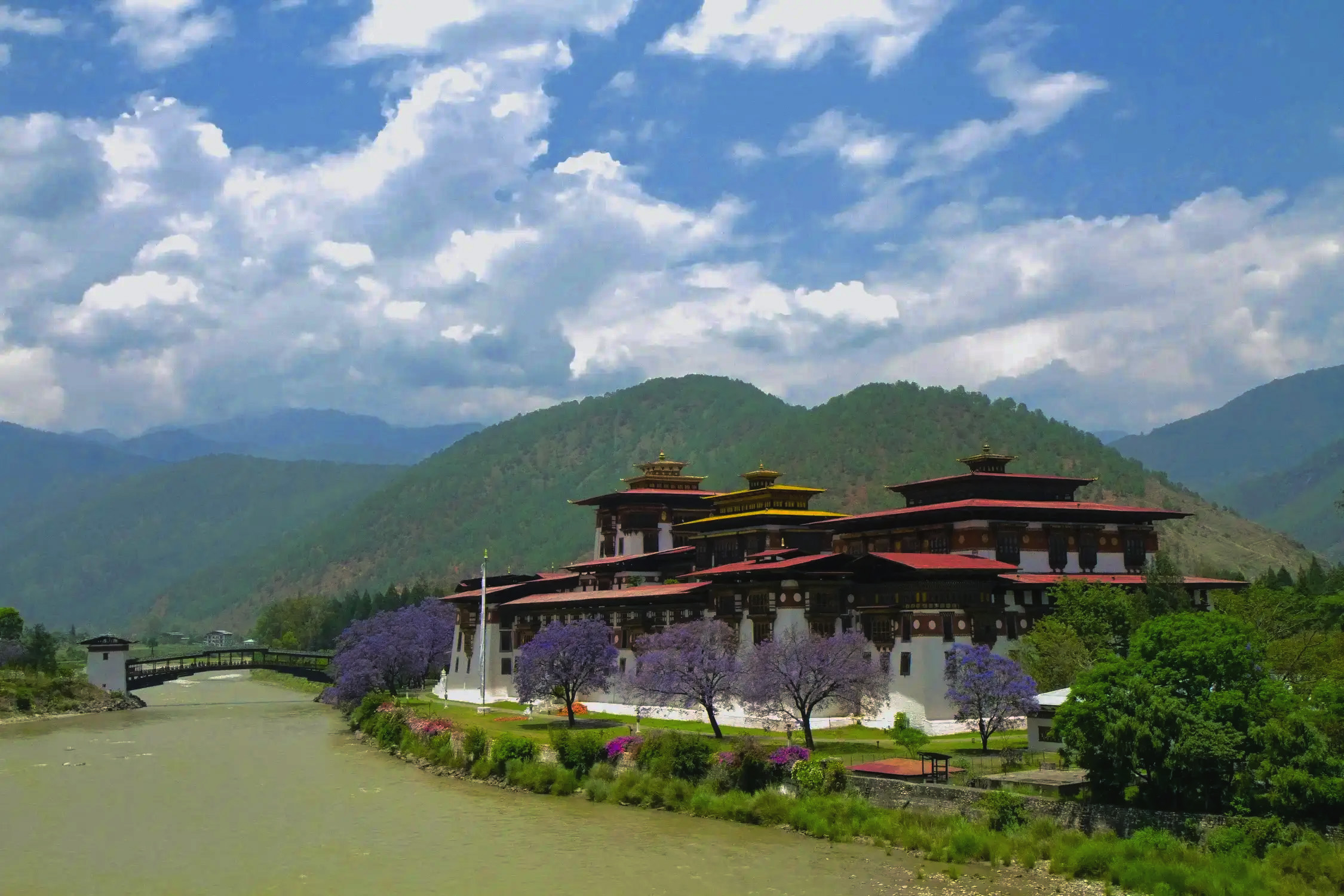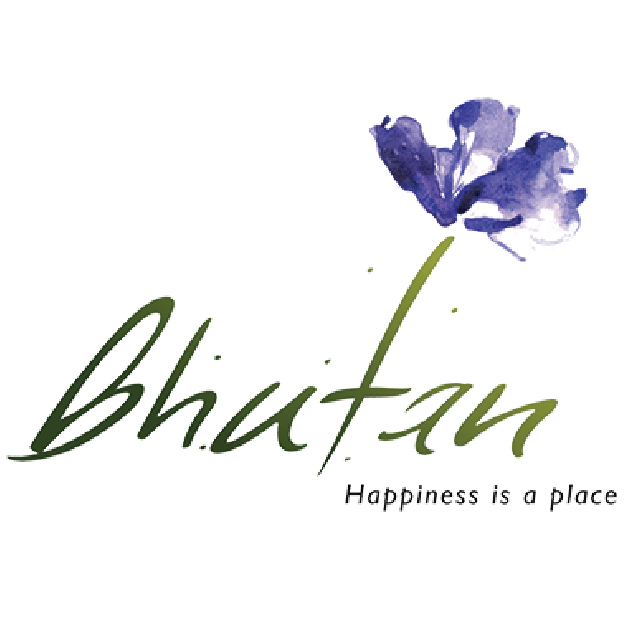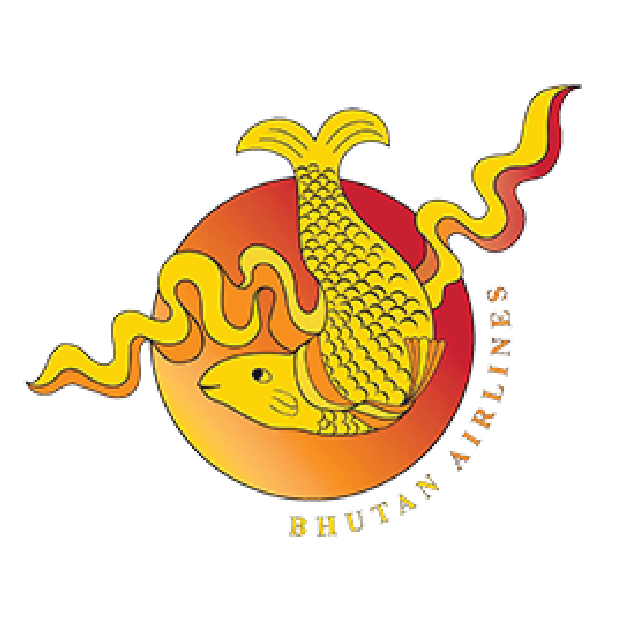TOP DESTINATIONS

Punakha Dzong
The Punakha Dzong, also referred to as Pungthang Dewa Chhenbi Phodrang, meaning the Palace of Great Happiness, stands as a majestic testament to Bhutan's rich cultural heritage. Constructed by Zhabdrung Ngawang Namgyal in 1637-1638, this fortress is a profound embodiment of Buddhist values and one of 16 dzongs commissioned during his reign from 1594 to 1651. Once the capital and governmental seat of Bhutan until 1955, it now serves as the winter residence of the Central Monastic Body. Punakha Dzong stands out as one of Bhutan's most exquisite architectural marvels, particularly enchanting in spring when lilac-hued Jacaranda trees adorn its surroundings with lush beauty.
Fun Facts about Punakha Dzong
- Punakha Dzong is the second oldest & the second largest Dzong in Bhutan
- The dzong measures 180 m (590 ft) in length and 72m (236 ft)
- It was the capital of Bhutan until 1955
- The Dzong houses the sacred relics of the southern Drukpa Lineage of the Kagyu School of Tibetan Buddhism, including the Rangjung Karsapani and the sacred remains of Zhabdrung Ngawang Namgyal and the Terton Pema Lingpa.
- It is listed as a tentative site in Bhutan’s Tentative List for UNESCO inclusion.
- The dzong was destroyed by fire at least six times in the years 1780, 1798, 1802, 1831, 1849, and 1986. In the 1897 earthquake, the dzong was severely damaged and also suffered numerous fires. In 1986, the dzong was partially destroyed by fire. In 1994, a glacial lake outburst on the Pho Chhu also cased damage to the Dzong.
- The Punakha Dzong has 3 courtyards (Docheys) instead of the usual 2 like other Dzongs.
- The 17th century Bazam (Bridge) which serves as the main access to the Dzong was washed away by floods in 1957. The bridge was rebuilt in 2008 (2006-2008). The Bazam is about 55 Meters in length.
- Like other traditional structures in Bhutan, Punakha Dzong was built without an architectural drawing/blueprint of the plan.
- In addition to its strategic position at the river confluence, the dzong has several other features to protect it against invasion. The steep wooden entry stairs are designed to be pulled up, and there is a heavy wooden door that is still closed at night.
Historical Events at Punakha Dzong
- The Dzong was attacked by Tibetan troops in 1639 and a subsequent attack in 1644 with the Bhutanese warriors emerging victorious on both accounts.
- The first king of Bhutan, Sir Ugyen Wangchuk received the order of the Knight Commander of the Indian Empire (KCIE) by John Claude White at the Punakha Dzong in 1905.
- Punakha Dzong was the site of the coronation of Sir Ugyen Wangchuk as the first Druk Gyalpo (first King) of Bhutan when the monarchy was established in 1907.
- A treaty between the British & Bhutan was signed at the Punakha Dzong whereby the British agreed not to interfere in Bhutanese internal affairs and Bhutan allowed Britain to direct its foreign affairs.
- First National Assembly was held at Punakha Dzong in 1953.
- Punakha Dzong hosted the coronation of his Majesty the fifth king of Bhutan, Jigme Khesar Namgyel Wangchuck in 2008. In fact, it is the venue for the coronation of all the kings of Bhutan till date.
- Also, the Je Khenpos (head of secular affairs) begin their reigns by receiving the blessed five-coloured scarf from the inner sanctum of the sacred Machen Lhakhang in Punakha Dzong
- The Dzong also served as the venue for the royal wedding of the fifth king, Jigme Khesar Namgyel Wangchuck and Queen Jetsun Pema on 13th October, 2011.
Geography – Location of the Punakha Dzong
The Punakha Dzong sits at the junction of two rivers, the Pho Chhu (Male River) and Mo Chhu (Female River). The Mo Chhu originates from the northern hills of Lingzhi and Laya in Bhutan, as well as Tibet, while the Pho Chhu is sustained by glaciers in the Lunana region of the Punakha Valley. Upon merging, these rivers form the Punatsang Chhu or Sankosh River, which flows through Wangdue Phodrang, crosses into India at Kalikhola along the Bhutan-India border, and eventually joins the Brahmaputra River.
Architecture – The drawing Imprinted in the Mind!
Similar to other ancient structures in Bhutan, the Punakha Dzong was constructed without architectural or structural drawings. According to a prophecy made by Guru Padmasambhava in the 8th century, it was foretold that a young man named Namgyel would arrive at a mountain resembling a sleeping elephant and build a Dzong on the elephant's trunk. This prophecy came to fruition when Zhabdrung Ngawang Namgyel built the Punakha Dzong in 1637.
Legend has it that the architect, Zow Balep, received a vision in a dream after being instructed by Zhabdrung to sleep in a small structure (known as Dzong Chung, meaning small Dzong) containing a Buddha statue. Influenced by the spiritual powers of Zhabdrung, Zow Balep had a vivid vision of a palace for Guru Rinpoche in his dream. This vision was etched in the architect's mind, enabling him to conceptualize the Dzong's design without the need for written plans. Consequently, based on the architect's dream vision, construction of the Dzong commenced in 1637 and was completed in 1638, at the site where Dzong Chug once stood. Additionally, local beliefs suggest that the construction of the Dzong received assistance from the local deities.
In 1639, a chapel was constructed at Punakha Dzong to commemorate the victory over Tibetan invaders, housing the seized arms. Additionally, Zhabdrung established a monastic community of 600 monks from Cheri Gompa in the upper Thimphu Valley. Zhabdrung lived in Punakha Dzong until his passing in 1651.
In 1676, Gyaltsen Tenzin Rabye, the Dzong's abbot, added the spire atop the utse (central tower). Further expansion occurred from 1744 to 1763 under Sherab Wangchuk's rule, with significant contributions such as a grand Thangka (known as chenma (great) thoundral) of Zhabdrung donated by Sherab Wangchuk himself and a brass roof gifted by the 7th Dalai Lama. The grand Thangka is displayed to the public during the annual Punakha Tshechu.
The dzong spans 180 meters in length and 72 meters in width, featuring three courtyards and defensive fortifications including a steep wooden draw stairway and a sturdy door closed at night to safeguard against enemy attacks.
Extensive refurbishment in the traditional "zorig chusum" crafts tradition resulted in the addition of new Lhakhangs, over 200 religious images, and various treasures. A consecration ceremony, the "Rabney ceremony," conducted by the Je Khenpo and Dratshang monks, took place from May 13 to 15, 2004. Additionally, a memorial honoring the 23 individuals who lost their lives in the 1994 glacial floods was erected outside the dzong.
According to Her Majesty, the Punakha Dzong resembles a mighty ship anchored in place (Wangchuck, p.102). This comparison is fitting, considering the fortress-monastery's dimensions of 180 meters by 72 meters, with walls tapering at both ends. The central utse (tower), rising six stories high, serves as the "ship's" superstructure, offering sweeping views across the valley. Due to its relatively low elevation, during periods of flooding, the dzong must stand firm against the combined force of the adjacent rivers, embodying the metaphor of a ship facing turbulent waters.
Local Deities at Work for the Construction of Punakha Dzong
Her Majesty Ashi Dorji Wangmo Wangchuck, the Queen Mother of Bhutan, shares local beliefs that attribute the construction of the dzong to the assistance of various deities. Nobgang, the protective deity of a nearby village, and Dorichum, known as the Lady of the Stones, are said to have orchestrated a landslide that provided the necessary building materials for the walls. Additionally, the dzong's timber was reportedly supplied by the protective deity of Tsachaphu village, who facilitated its transportation downstream for the Zhabdrung's workers.
The Attractions - The unusual 3 Courtyards & others
The first Courtyard (Northern Courtyard)
The first courtyard accommodates the administrative offices of the Dzong, alongside notable features such as a large white Stupa and a bodhi tree. Additionally, within this courtyard, positioned to the far left, lies a mound of rocks and a shrine dedicated to the queen of the nagas.
The Second Courtyard
The second courtyard contains the living quarters for the monks and is divided from the first courtyard by the Utse (Central Tower). Within this area, two significant halls stand: one dedicated to Ugyen Wangchuck, who later ascended to become the King, and another hall where the King received the Order of the Knight Commander of the Indian Empire from John Claude White in 1905.
The Third Courtyard (southernmost courtyard)
In the third courtyard, situated at the southernmost part of the dzong, lie the preserved remains of Pema Lingpa and Ngawang Namgyal. Machey Lakhang, meaning "sacred embalmed body," houses the remarkably well-preserved body of Zhabdrung. The Machey Lhakhang was rebuilt in 1995. The casket containing Zhabdrung's embalmed body remains sealed, accessible only to two guardian lamas, the king, and the Je Khenpo, who seek blessings before assuming their duties.
Additionally, within the Dzong, the preserved body of Zhabdrung's son, Jampel Dorji, is kept. While Zhabdrung's remains are housed in the Marchen Lhakhang, dedicated solely to his memory, his son's remains are placed in the Utse (central tower).
Kunrey – Hundred Pillar Assembly Hall
At the southern end stands the Kunrey, or 'hundred-pillar' assembly hall, though it actually contains only 54 pillars. This hall, commissioned by the second Druk Desi, boasts remarkable murals portraying the life of Buddha. Dating back to the mid-18th century, the hall features imposing gold statues of the Buddha, Guru Rinpoche, and the Zhabdrung, along with intricate gold panels embellishing the pillars. The meticulously painted gold, red, and black carved woodwork contribute to the dzong's artistic grandeur, despite its monumental size.
Tse Lhakhang – The home of Rangjung (Self-created) Kharsapani
Stored in the Utse of the Dzong is another revered national treasure known as the Rangjung Kharsapani, which Zhabdrung brought with him upon fleeing Tibet. This sacred relic is a self-manifested representation of Avalokiteshvara (Chenrezig), created from vertebrae belonging to Tsangpa Gyare (1161-1211), the founder of the Drukpa lineage. Displayed exclusively during the Punakha Domchoe, this relic holds significant religious and cultural importance for Bhutan.
Dzong Chung – Wish-fulfilling Statue of Sakyamuni
Upon departing the Dzong from the northern direction, visitors have the opportunity to explore the Dzong Chung, where they can receive blessings from a wish-fulfilling statue of Sakyamuni, believed to have originated as early as 1326. This building marks the site of the original Dzong. To the north of the dzong lies a cremation ground, identified by a sizable chorten, while to the east stands a royal palace.
Stairs – The 3 Section Steep Stairs
The primary entrance to the Dzong is characterized by a set of steep stairs divided into three sections. While the stairs on the sides are accessible to the general public, the central stair is reserved exclusively for the Royal Family. Designed with flexibility in mind, these stairs can be folded or removed during times of conflict to fortify the Dzong and make it impregnable.
Festivals
The annual Domche festival held at the Dzong attracts a large crowd from villages and distant areas of the district. During this five-day event, also known as the Punakha festival, in February or March, various impressive displays take place. One significant feature is the reenactment of the Tibetan invasion of Bhutan in 1639 and 1644, culminating in a mock throwing of a relic into the Mo chu river, as conceived by the Zhabdrung. The rangjung "self-created" image of Avalokiteśvara enshrined in the utse of the dzong (brought by the Zhabdrung from Tibet) is displayed during the festival.
On the final day, festivities include the display of an image of Zhabdrung, followed by a group dance performance by 136 individuals dressed as warriors in the main courtyard. After the performance, the dancers descend from the dzong's front entrance, accompanied by whistling and shouting, while the monks led by the Je Khenpo parade to the Mo chu river bank, where oranges are thrown into the river as an offering to the nāgas. Traditional mask dances commemorating the dzong's construction are also performed during the festival.
Additionally, an annual ritual called Lhenkey Dungchhur, a worship for departed souls, is observed at the dzong.
Best Time to Visit Punakha
Best for Photography (Rhododendrons & Other Flowers)
-
March – May: The best time to visit if you are keen about photography and natural beauty with valleys and hillsides filled with vibrant colours of rhododendrons, magnolias and cherry blossoms.
- September – October: September and October months are also good with a second wave of blossoms. The rustic allure of golden-red buckwheat fields will definitely captivate you.
Best for River Rafting
- June – August: The Mo Chhu is at its highest flow during the monsoon season, thus providing the most intense river rafting experience. We recommend it for only experienced rafters. However, at times, the facilities stay shutdown due to heavy rainfalls.
- March – May: The thawing of snow cases the Mo Chhu River to rise, and this season is recommended for intermediate and advanced rafters.
- September – October: The water rapids are slow during this time, and we recommend this for beginner rafters who would enjoy a slow rafting experience while enjoying the surrounding scenic beauty. The valleys and hillsides will be colorful during this time, so you can enjoy a mixture of scenic beauty and rafting experience.
How to plan for a Punakha Trip?
Planning a trip can be exhausting and time consuming when you don’t have much idea about your destination. Every information is available on the net nowadays; however, it is time consuming and can get pretty confusing at times. The best and the easiest way to plan and customize your trip is to get help from a travel expert available at your disposal. Contact our team of expert travel professionals, and plan your trip to Bhutan.




